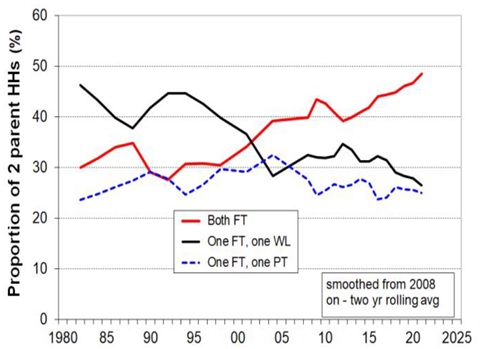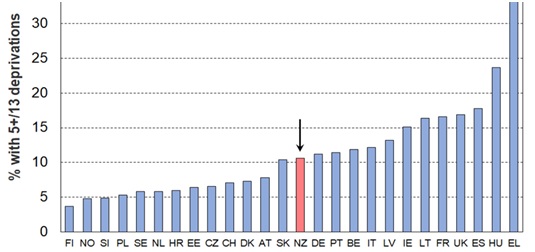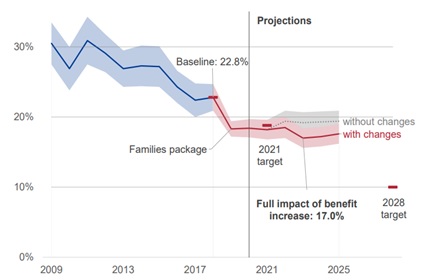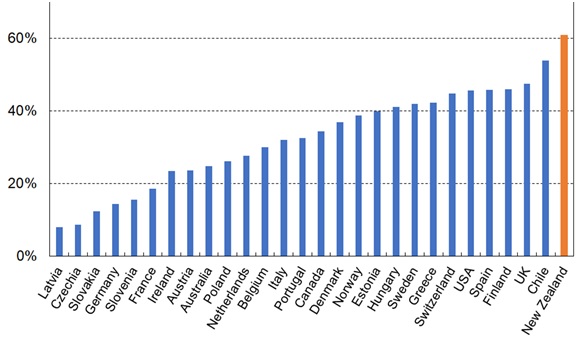POVERTY IN NEW ZEALAND - AT THE CROSSROADS
- Greg Waite
Today, new ways to reduce poverty in Aotearoa are more visible and achievable, an unexpected result of the covid-19 pandemic, because we managed the pandemic differently than most countries. Temporary closures of international borders have produced an unusual combination of circumstances: low interest rates and unemployment, disrupted inflows of cheap labour, higher costs for goods and housing. Workers' bargaining power has increased with, for example, First Union negotiating an increase of 12% for Countdown staff, E Tu members in Nelson's Southpine mill winning 7.2% after a snap strike, and pulp and paper workers at Kawerau awarded 5% plus $4,000 by the Employment Relations Authority (ERA) after a lockout.
Labour's new Fair Pay Act is another limited step forward, bringing back collective industry bargaining. I attended a presentation by Workplace Relations Minister Michael Wood, which included a chart showing productivity rising faster than worker income to make the case that increasing wages is a fair response. True, but the statistic is a less pointed version of a chart highlighted in my analysis of Bill Rosenberg and Geoff Bertram's "Inequality And Excess Profits In New Zealand" (Watchdog 158, December 2021) where labour's share of productive income is falling because capital keeps taking more.
The downside is this Act transfers decisions to the ERA when unions and employers can't reach an agreement. Agreements also have to be vetted by the Ministry of Business, Innovation and Employment (MBIE), so bureaucracy will limit the number of agreements each year and likely restrict them to industries with chronic underpayment. That won't do much to build union militancy or coverage, which stands at just 19% in Aotearoa in 2022 (International Labour Organisation) but is on the rise.
Achieving real change in the employer-employee balance of power won't be easy. Workers aren't happy, but they are understandably cynical about Government when Labour and National both supported the free market policies which got us here. And they are already on a treadmill, working longer hours to afford the most expensive housing in the world (1) and now facing rising costs caused by pandemic and war disruption. The chart below shows the steady climb in the proportion of couples with both partners working full-time to get by, and I've seen in my own research a rapid rise in individuals working 60 hours in a week.
Chart 1. Increasing Proportion Of Couples With Children Where Both Work Full-Time

Labour made poverty reduction a key priority when elected in 2017, but focussed on increasing inadequate benefits and minimum wages. If we continue down this road, the future world will see the super-wealthy taking more and more, controlling the political agenda, while low wages and a social safety net trap workers on a treadmill to nowhere. Building on the recent revival of worker power is the real key to reversing the rises in poverty we've seen from forty years of free markets. More money needs to return to people doing the work, less to the owners, managers and their overpaid supporting hierarchy. Today's wage increases do not have to be just a temporary response to temporary circumstances.
Poverty: An International Comparison
New Zealand's poverty rate is similar to Slovakia, Germany, Portugal, Belgium and Italy; worse than Switzerland ("CH"), Denmark and Austria; much worse than Finland, Norway, Slovenia and Poland; but well below France, UK, Spain, Hungary and Greece ("EL") in this 2020-21 data. We are still among the high-poverty group of countries, despite significant improvement in recent years due to policy changes targeting poverty.
Chart 2. Deprivation (Percent Of Households With Children Who Cannot Afford Five Or More Essential Items)

Progress On Poverty, So Far
The trend shown below is taken from Treasury's report accompanying the 2021 Budget and shows lower unemployment and Government policies combining to reduce poverty. The chart also makes clear that significant new initiatives will be needed to reach our 2028 target. A critical point here is that about half the households with children in poverty are working - so reducing poverty is not just about increasing benefits. Increasing wages, training, job security and career pathways are also critical, as are reduced housing costs, food security and other indirect assistance.
Chart 3. Proportion Of Children In Households Below 50% Of Median Income After Housing Costs

Bad housing policy is a huge contributor to poverty in Aotearoa. Between 2000 and 2021 we had the largest increase in real housing prices in the Organisation for Economic Cooperation and Development (OECD), and rental affordability for low- income households is clearly the worst in the OECD (2) with over 60% paying more than 40% of their income on rent.
Chart 4. Percent Of Low- Income Earners (Lowest 20%) In Private Rental Paying Over 40% Of Income On Rent

In 2022 I was at a Child Poverty Action Group workshop to refine its priorities. One of the participants made the point that housing in Aotearoa is a clear case of complete market failure - and a spontaneous cheer came from the group. We all know what free markets mean - developers make more from the building for the rich and build nothing for lower incomes. It's time to move on Governments having to defer to market solutions. There are options. The Government can change the rules so affordable housing has to be part of new developments, or incentivise new vehicles for investment in large-scale affordable private housing, or just build it. Each approach has merits but the latter two are more likely to succeed. Market failure is here to stay, so we need to create new solutions.
Looking Ahead
The charts above highlight the seriousness of child poverty in New Zealand but they rely on surveys up to 2020-21, so do not include the impact of recent price rises, rising interest rates, and the possibility of recession. Looking ahead, we can expect much sharper debate about the conflicting agendas of business and labour - "unemployment needs to rise to rein in inflation" vs "wages need to rise to get by". And an election is looming. In difficult times like these, poverty will rise sharply if a red-green coalition doesn't get enough votes to continue in Government. Now is the time to support militant unions, to support the parties which will make a difference, and to pressure those parties to adopt new policies which create a fairer future.
Endnotes
- Housing Affordability For Renters And Owners: International Comparisons, p.7, Ministry of Social Development (2021).
- As above.
Non-Members:It takes a lot
of work to compile and write the material presented on these pages - if
you value the information, please send a donation to the address below to
help us continue the work.
Foreign Control Watchdog, P O Box 2258, Christchurch, New Zealand/Aotearoa.
Email

